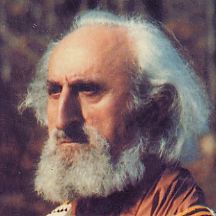Frithjof Schuon: Questions and Answers
I. Spirituality 
Question : You have written more than
twenty books on religion and spirituality. Your first book has the title The Transcendent Unity of Religions. May I ask you how one should
understand this unity?
Frithjof Schuon: Our starting point is the acknowledgment of the fact that there are diverse religions which exclude each other. This could mean that one religion is right and that all the others are false; it could mean also that all are false. In reality, it means that all are right, not in their dogmatic exclusivism, but in their unanimous inner signification, which coincides with pure metaphysics, or in other terms, with the philosophia perennis.
Q. : How can we know that this metaphysical meaning is the truth?
F.S.: The metaphysical perspective is based on intellectual intuition, which by its very nature is infallible because it is a vision by the pure intellect, whereas profane philosophy operates only with reason, hence with logical assumptions and conclusions.
Q. : This being so, what is the basis of religion?
F.S.: The religious, dogmatic or theological perspective is based on revelation; its main purpose is, not to explain the nature of things or the universal principles, but to save man from sin and damnation, and also, to establish a realistic social equilibrium.
Q. : If we have religion, which saves us, why do we also need metaphysics?
F.S.: It is because metaphysics satisfies the needs of intellectually gifted men. Metaphysical truth concerns not only our thinking, but it penetrates also our whole being; therefore it is far above philosophy in the ordinary sense of the word.
Q. : On the spiritual level, what does every human being need?
F.S.: Three things: truth, spiritual practice, morals. Pure and unveiled truth coincides with metaphysics; the religious dogmas are symbols of metaphysical truths; the deep understanding of religious symbolism is esoterism. Pure metaphysics is hidden in every religion.
Q. : And what about spiritual practice?
F.S.: Spiritual practice is essentially prayer. There are three forms of prayer: first, canonical prayer, for instance the Lord's prayer; second, personal prayer, whose best model is given by the Psalms; third, the contemplative prayer of the heart; this is mystical spirituality, which requires certain conditions. The story of the "Russian Pilgrim" offers an image of it; also Hindu texts about japa-yoga, methodical invocation.
Q. : And what about morals?
F.S.: This is, after truth and spiritual practice, the third dimension of spiritual life. On the one hand, morals mean a reasonable, healthy and generous behavior; on the other hand, it means beauty of the soul, hence intrinsic nobility. Without this quality, doctrine and spiritual practice would be fruitless.
Q. : You mentioned before intellectual intuition. Doesn't every man possess this faculty?
F.S.: Yes and no. In principle, every man is capable of intellection, for the simple reason that man is man; but in fact, intellectual intuition -- the "eye of the heart" -- is hidden under a sheet of ice, so to speak, because of the degeneration of the human species. So we may say that pure intellection is a gift and not a generally human faculty.
Q. : Is it possible to develop this higher intuition?
F.S.: There is no need to develop it. Man can be saved by faith alone. But it is evident that a very pious or contemplative person has more intuition than a worldly person.
II. Art
Q. : May I ask you what the role of art is in the spiritual existence of man?
F.S.: We could say that after morals, art -- in the broadest sense of the word -- is a natural and necessary dimension of the human condition. Plato said: "Beauty is the splendor of the true." So let us say that art -- including crafts -- is a projection of truth and beauty in the world of forms; it is ipso facto a projection of archetypes. And it is essentially an exteriorization in view of an interiorization; art does not mean dispersion, it means concentration, a way back to God. Every traditional civilization has created a framework of beauty: a natural, ecologically necessary surrounding for spiritual life.
Q. : What are the criteria for knowing the worth of a work of art, its level of inspiration?
F.S.: The archetypes of sacred art are celestial inspirations; all other artworks draw their inspiration from the spiritual personality of the artist. The criteria for knowing the worth of a work of art are: the content of the work, its mode of expression and its technique, its style.
Q. : Are the criteria different for various types of art: painting, sculpture, dance, music, poetry, architecture?
F.S.: No, the criteria are not different for various types of art.
Q. : With beauty, there is what one might call an ambiguous element, since it can be conducive to a worldly self inflatedness or on the contrary to a remembrance of the Divine. What is it about certain arts -- music, poetry and dance, for example -- that makes the ambiguous element more pronounced in them?
F.S.: Painting and sculpture are in a way more cerebral and objective than poetry, music and dance, which are more psychic and subjective; therefore the ambiguous element is more pronounced in these three arts.
Q. : Could one say that the Hindu notion of darshan has an application in experiencing art and beauty?
F.S.: Of course, the Hindu notion of darshan applies to any esthetic or artistic experience; but in this case it also involves mental and auditive perceptions, not only vision.
Q. : Could one say that there is a natural link between beauty in the broadest sense and esoterism?
F.S.: Yes, there is a link between beauty and esoterism, because "Beauty is the splendor of the True." Traditional art is esoteric, not exoteric. Exoterism is interested in morals, not in beauty; it even happens that exoterism can be opposed to beauty because of a moralistic prejudice.
Q. : Would it be legitimate to say that esoterism has certain rights in regard to art and beauty which transcend the limits and prohibitions laid down by the various exoterisms?
F.S.: In principle, esoterism has certain rights which transcend the prohibitions of exoterism, but in fact, esoterism can rarely make use of these rights. Nonetheless, it has occurred, for example, in the case of dervish dances or of apparently shameless Tibetan paintings.
Q. : Besides the "fine arts," there are--in Japan, for example--the art of flower arranging, the tea ceremony, even the martial arts, which are (or were originally) recognized as manifestations of a spiritual nature. How does it come about that an activity as "everyday" as preparing tea can become the vehicle of a spiritual barakah (grace)?
F.S.: The Zen arts -- like the Tea Ceremony -- crystallize certain manners of acting of the Buddha, or let us say: of Primordial Man; now the Buddha never handled a sword, but if he had, he would have done so like a Zen Master. Acting like the Buddha -- even at such a level as preparing tea -- means: to assimilate something of the Buddha-Nature; it is an open door to Enlightenment.
Q. : Modern art is not traditional. Does this mean that a modern artwork is necessarily bad?
F.S.: No, because a modern artwork -- modern in the broadest sense -- may manifest different qualities, in regard to the content as well as in regard to the treatment and also to the artist. Some traditional productions are bad, and some nontraditional productions are good.
Q. : What does art mean for the artist himself?
F.S.: By creating a noble work of art, the artist works on his own soul; in a way, he creates his own archetype. Therefore the practice of every art is a way of self-realization, in principle or also in fact. With unimportant or even negative subjects, the artist may remain intentionally unaffected, but with noble and profound subjects, he works with his very heart.
III. Primordiality
Q. : Your book The Feathered Sun reveals your interest in the American Indians. May I ask you what the stimulus of this interest or affinity is?
 F.S.: The Red Indians -- and especially the Indians of the Plains -- have much
in common with the Japanese samurai, who very often practiced Zen spirituality;
morally and aesthetically speaking, the Plains Indians were one of the
most fascinating peoples of the world. It was the great mistake of the
19th century to distinguish only between "civilized people" and "savages";
there are distinctions which are far more real and important, for it is
obvious that "civilization" in the ordinary sense is not the highest value
of mankind, and also that the term "savage" is not suitable to the Indians.
What makes the value of a man is neither his mundane culture nor his practical
or inventive intelligence, but his attitude in the face of the Absolute;
and he who has the sense of the Absolute never forgets the relationship
between man and virgin Nature, because Nature is our origin, our natural
homeland and a most transparent Message of God. For the Arab historian
Ibn Khaldun, the very condition of a realistic civilization is the equilibrium
between Bedouins and city dwellers, which means between nomads and sedentaries;
between the healthy children of Nature and the representatives of elaborated
cultural values.
F.S.: The Red Indians -- and especially the Indians of the Plains -- have much
in common with the Japanese samurai, who very often practiced Zen spirituality;
morally and aesthetically speaking, the Plains Indians were one of the
most fascinating peoples of the world. It was the great mistake of the
19th century to distinguish only between "civilized people" and "savages";
there are distinctions which are far more real and important, for it is
obvious that "civilization" in the ordinary sense is not the highest value
of mankind, and also that the term "savage" is not suitable to the Indians.
What makes the value of a man is neither his mundane culture nor his practical
or inventive intelligence, but his attitude in the face of the Absolute;
and he who has the sense of the Absolute never forgets the relationship
between man and virgin Nature, because Nature is our origin, our natural
homeland and a most transparent Message of God. For the Arab historian
Ibn Khaldun, the very condition of a realistic civilization is the equilibrium
between Bedouins and city dwellers, which means between nomads and sedentaries;
between the healthy children of Nature and the representatives of elaborated
cultural values.
Q. : Your art books The Feathered Sun and especially Images of Primordial and Mystic Beauty deal with the mystery of sacred nudity. Could you explain in a few words the meaning of this perspective?
F.S.: Sacred nudity -- which plays an important role not only with the Hindus but also with the Red Indians -- is based on the analogical correspondence between the "outmost" and the "inmost": the body is then seen as the "heart exteriorized," and the heart for its part "absorbs" as it were the bodily projection; "extremes meet." It is said, in India, that nudity favors the irradiation of spiritual influences; and also that feminine nudity in particular manifests Lakshmi and consequently has a beneficial effect on the surroundings. In an altogether general way, nudity expresses -- and virtually actualizes -- a return to the essence, the origin, the archetype, thus to the celestial state: "And it is for this that, naked, I dance," as Lalla Yogishvari, the great Kashmiri saint, said after having found the Divine Self in her heart. To be sure, in nudity there is a de facto ambiguity because of the passional nature of man; but there is not only the passional nature, there is also the gift of contemplativity which can neutralize it, as is precisely the case with "sacred nudity"; similarly, there is not only the seduction of appearances, there is also the metaphysical transparency of phenomena which permits one to perceive the archetypal essence through the sensory experience. St. Nonnos, when he beheld St. Pelagia entering the baptismal pool naked, praised God for having put into human beauty not only an occasion of fall, but also an occasion of rising towards God.
IV. Message
Q. : What would be your message for the average man?
F.S.: Prayer. To be a human being means to be connected with God. Life has no meaning without this. Prayer and beauty, of course; for we live among forms and not in a cloud. Beauty of soul first, and then beauty of symbols around us.
Q. : You have spoken of metaphysics. May I ask you what the main content of this perennial wisdom is?
F.S.: Metaphysics means essentially: discernment between the Real and the apparent, or the illusory; in Vedantic terms: Atma and Maya ; the Divine and the cosmic. Metaphysics is concerned also with the roots of Maya in Atma,-- this is the Divine Personification, the creating and revealing God -- and then with the projection of Atma into Maya -- this means everything that is positive or good in the world. And this is essential: metaphysical knowledge requires intellectual, psychic and moral assimilation; discernment requires concentration, contemplation and union. Therefore metaphysical theory is not a philosophy in the modern sense of the word; it is essentially sacred. The sense of the sacred is an indispensable qualification for metaphysical realization, as it is for every spiritual way. For the Red Indian, as also for the Hindu, everything in nature is sacred; this, modern man has to learn, because it is a question of ecology in the broadest' sense of the word. What is needed first, is prayer; and then: back to Nature! One could object that it is too late; now, each person is responsible for what he or she does -- not for what others do -- because each one stands before God and can do what is requested for his immortal soul. The first step back to Nature is dignity; dignity of forms and of behavior; this creates the climate in which prayers feel at home, because dignity partakes of the immutable Truth.

